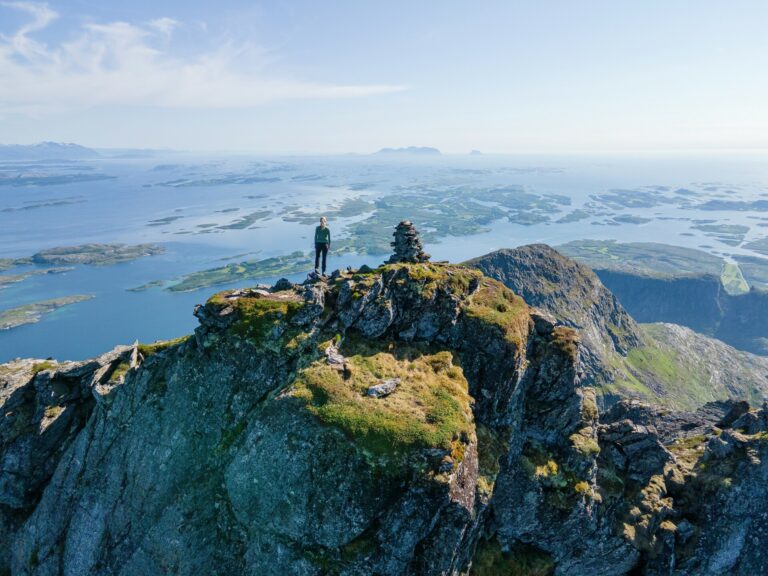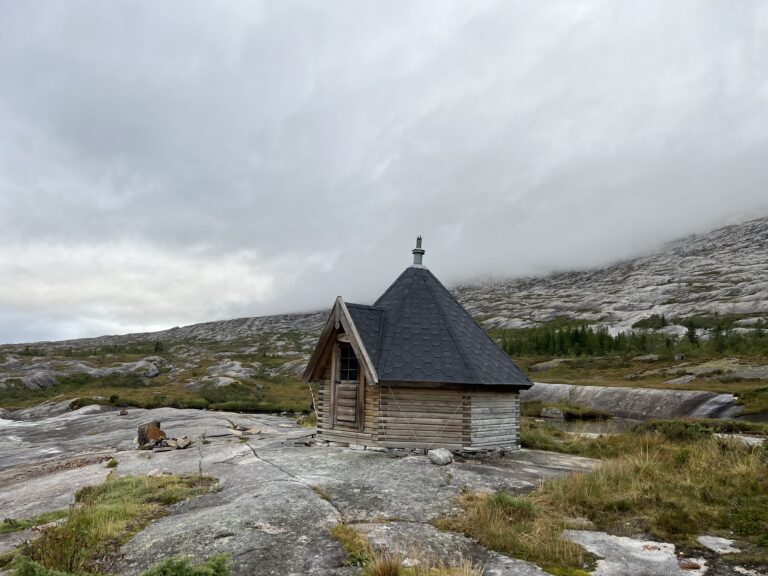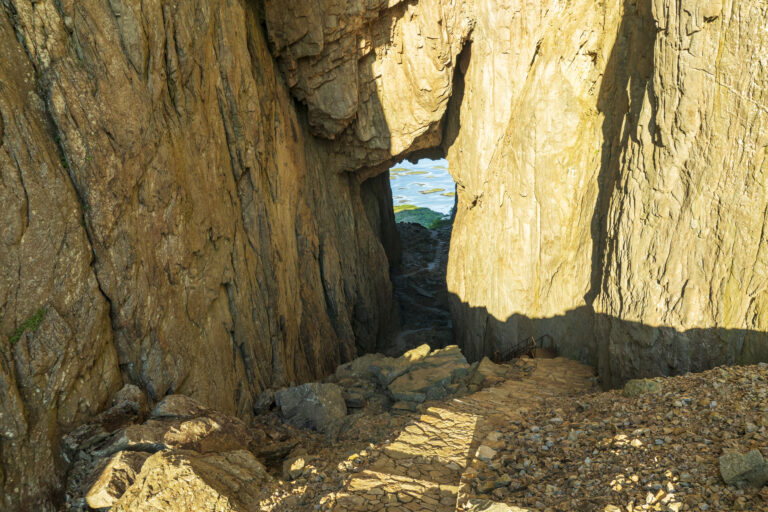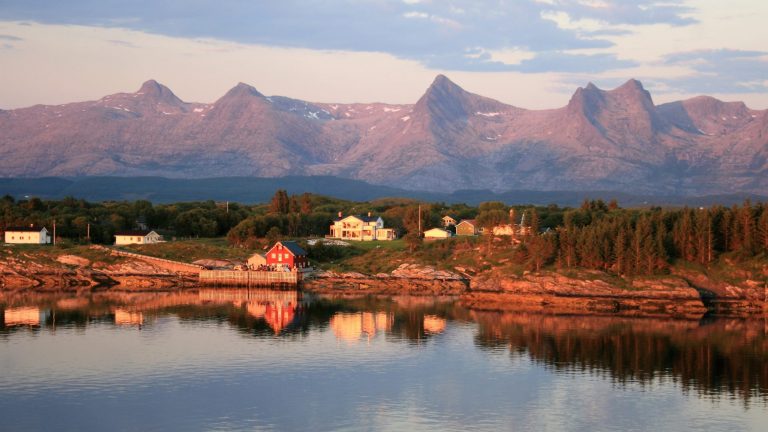A hiking adventure: Kjølen and Hammarøyfjellet
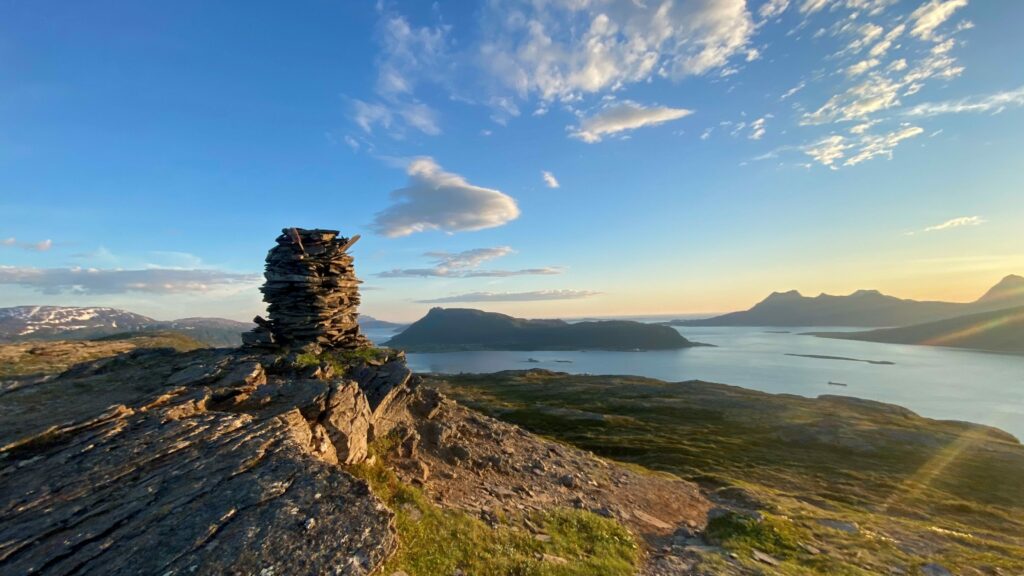 Halvor Hilmersen
Halvor HilmersenFrom Kjølen in Nesna, you can enjoy the midnight sun or a beautiful sunset. You can also extend the hike to the summit of Hammarøyfjellet.
Key info
Difficulty: Moderate to demanding
Distance one way: 8 km
Elevation gain one way: 760 metres
Time one way: 2–3 hours
Season: June – October
Special precautions: If you’re continuing all the way to Hammarøyfjellet, clear weather and good visibility are important so you don’t lose the trail.
View starting point on Google Maps
The distance and elevation figures above apply if you hike all the way to the top of Hammarøyfjellet.
You can park at the starting point at the end of Sørvollvegen, near a power station.
The trail goes through varied terrain with some steep sections. It is marked with red paint all the way to the summit.
You can choose to end your hike at Utsikten (226 m), Kjølen (447 m), or continue to the top of Hammarøyfjellet (760 m).
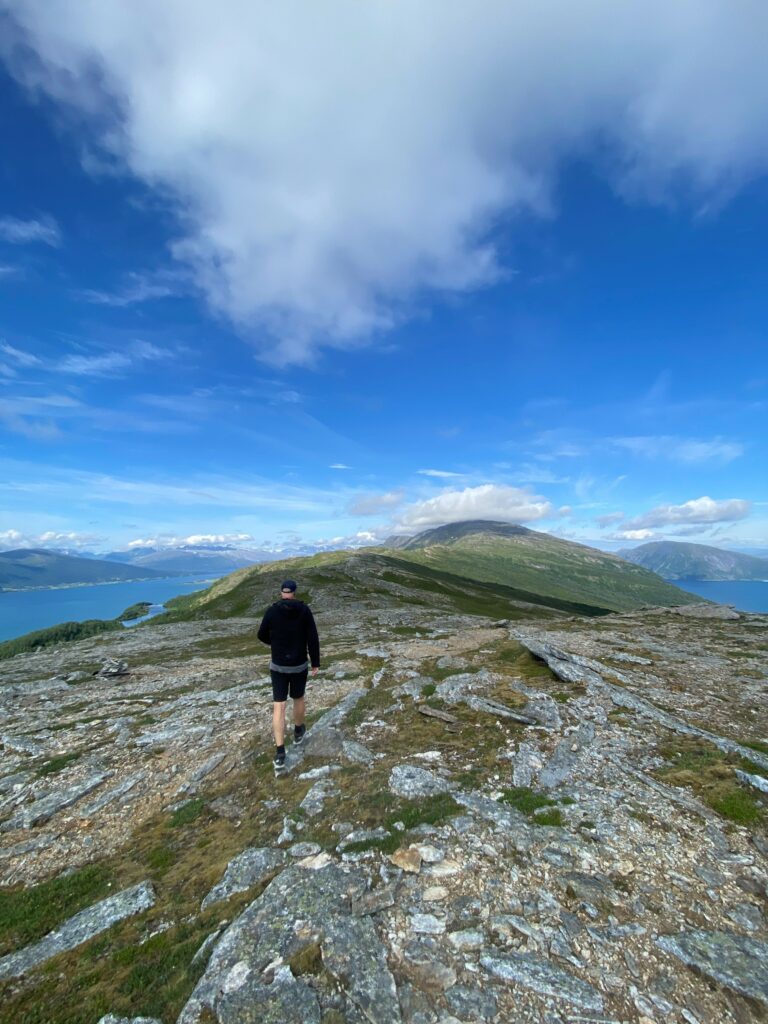 Halvor Hilmersen
Halvor Hilmersen
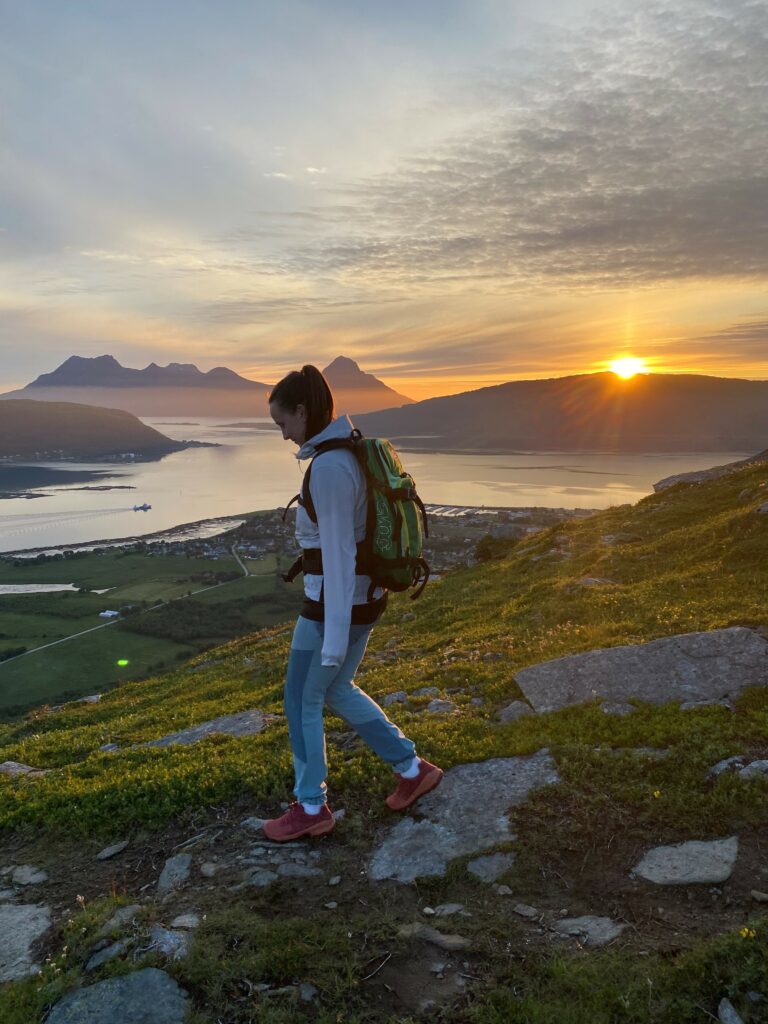 Halvor Hilmersen
Halvor Hilmersen
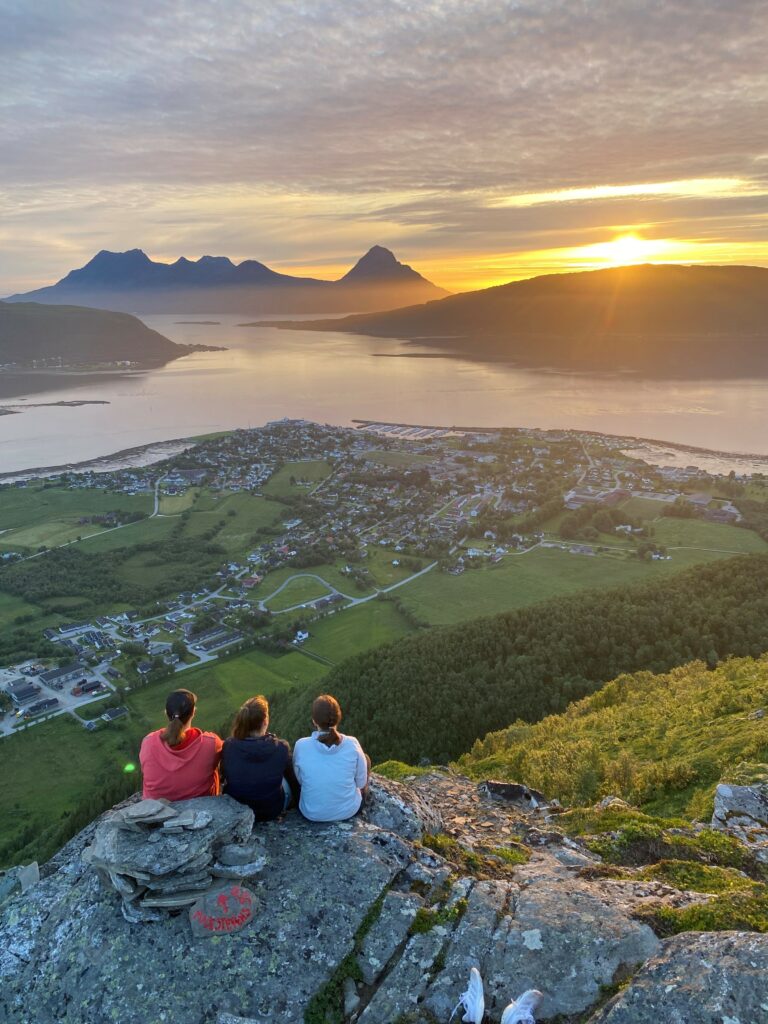 Halvor Hilmersen
Halvor Hilmersen
At the top of Kjølen, you’ll find a large stone cairn. The first stretch beyond Kjølen is relatively easy, followed by steeper climbs. From Kjølen, allow about 1.5 hours one way to reach the summit.
You’ll get panoramic views of the Helgeland coast as early as Utsikten.
1. Follow the Norwegian Mountain Code and plan according to your ability and equipment
Short hikes on easy terrain don’t require much. If you’re heading out for an hour or two in the lowlands and not gaining much elevation, you won’t need a lot of gear or be in top shape. If it gets cold or you get tired, you’re usually not far from your car.
But if you’re heading into more challenging terrain—steeper, rougher, and above the treeline where the weather is more unpredictable—you’ll need to be better prepared. You should plan the trip based on weather and conditions, be fit enough to complete it, and be ready for uneven ground, boulder fields, slippery roots, and stream crossings. That means carrying a heavier pack with extra clothes and gear, and wearing sturdy hiking boots that support your ankles.
If you’re unsure about taking on a demanding mountain hike, start with an easy or moderate one and see how it feels.
Learn more about the Norwegian Mountain Code at rodekors.no
See what you should bring on your hike on VisitNorway.com
2. Stick to marked trails
A shortcut through unfamiliar terrain can easily turn into a long and difficult detour. What looks like a trail might just be a sheep path that leads you somewhere completely unexpected. If you want the hike to be as easy or challenging—and as long or short—as planned, it’s best to follow marked trails.
If you’re heading off-trail, it’s smart to follow a GPS track. You can download a GPX file from a hike description and use it on a GPS device, a smartphone app, or a GPS watch.
UT.no and the UT app offer hike descriptions with GPS tracks. If your hike doesn’t have one, you can upload a track to ut.no/mine-turer and access it in the app. It’s free, but you’ll need to create an account.
Always carry a map and compass as backup.
UT app for Android / UT app for iPhone
3. Talk to locals or join a guided hike
Locals often have useful tips about your planned hike. They can tell you where to park, whether there’s phone coverage, if the trail is wet, if rivers are high, or suggest a better alternative. Talk to the people where you’re staying, at the local tourist office, or other hikers on the trail—you might get some truly valuable advice.
The best option is to hike with a guide. You can join a group tour or book a private guide. These are experienced locals who know the area well. They’ll help tailor the hike to your needs and share insights that add to the experience.
4. Look out for cultural landmarks
Even high up in the mountains, you’ll find traces of past human activity—some hundreds or even thousands of years old. These can include ancient trail markers, signal cairns, hunting fences, huts, and shepherd shelters. If you spot something interesting, check the KulturPunkt app to see what it is—or use the app to find a cultural site as your hiking goal.
KulturPunkt app for Android / KulturPunkt app for iPhone
KulturPunkt.org
5. Remember your responsibilities under the Right to Roam
Norway’s Right to Roam means you can hike, bike, pick berries, camp, fish, and ski almost anywhere in nature. But it also comes with responsibilities—what we call the “duties of the Right to Roam.” Leave no trace, respect wildlife, and know the rules for hunting, fishing, cycling, and access in protected areas like national parks and nature reserves.
Read more about the Right to Roam and your responsibilities at VisitNorway.com
Thank you for respecting the local communities, and for helping us preserve the natural beauty of Helgeland!
Please:
- Strive to leave no trace of your visit. Bring back all your rubbish, including used toilet paper, and discard it in the nearest rubbish bin.
- Plan your toilet visits and use the opportunity when you pass a toilet. In the wilderness, make sure you are not a nuisance to others.
- Respect the local wildlife. Keep a good distance from wildlife, livestock and birds. Keep your dog leashed.
- Respect private property. Keep a respectful distance from houses and cabins.
- Show good boating sense. Keep a good distance from shore and drive at a low speed, especially when you are close to anyone or anything on the water, including birds or animals. Avoid loud and disturbing engine noise. Be aware that some islands and nature reserves are important nesting sites, and that going ashore is prohibited during the nesting season.
- Follow the Norwegian Mountain Code (Fjellvettreglene). Plan your excursion according to the weather forecast, your skills and experience.
- Join a guided excursion or consider hiring an experienced guide, especially when you don’t have sufficient experience or knowledge to guarantee a safe trip.
Find accommodation, food, and activities nearby

Nordland National Park Centre – fine art and natural history
There is much to learn about the amazing wilderness and national parks of Nordland County – and the exhibitions at the Nordland National Park Centre aim to inspire this and much more. The centre offers something for the whole family, with exciting activities for young and old, such as walking the trails in the beautiful surroundings.
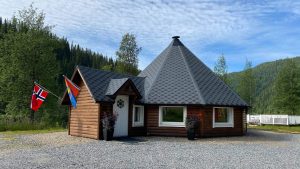
Storli Camping and Aernie – Accommodation and a sámi experience
At Aernie, you can indulge in culinary and cultural experiences based on the history and traditions of the Southern Sami people. You can stay overnight in a luxury Sami hut or in a cabin, motorhome, caravan, or tent. Storli Camping and Aernie are located along the E6, a 20-minute drive north of Mo i Rana.
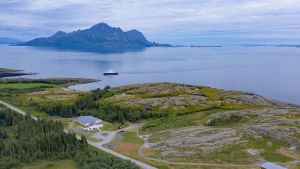
Grønsvik coastal fortress, Lurøy
If you want to see an unusual attraction and gain insights into World War II history, we recommend a visit to the old German coastal fortress at Grønsvik, which is now a museum. As you walk from the attractive parking lot and picnic area, you enter a dark chapter of European history.

Brasserie 8622
On September 7, 2023, Brasserie 8622 opened its doors in newly renovated premises in the center of Mo i Rana. The menu is inspired by French cuisine, made with top-quality local ingredients.

Restaurant Sjyen
With delicious food, fine wine, beautiful views, and a casually elegant atmosphere, Sjyen is a great choice for a memorable meal, perfect for any day or a special celebration. Here, you’ll find fresh, modern dishes that showcase the best of the sea – or “sjyen,” as the locals say.


